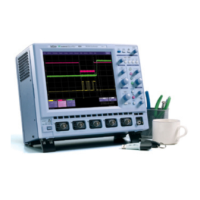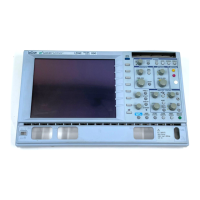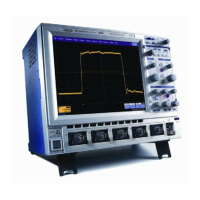X-Stream Operator’s Manual
WM-OM-E Rev I 237
Frequency Range The range of frequencies computed and displayed is 0 Hz (displayed at the
left-hand edge of the screen) to the Nyquist frequency (at the rightmost edge of the trace).
Frequency Resolution In a simple sense, the frequency resolution is equal to the bin width Delta
f. That is, if the input signal changes its frequency by Delta f, the corresponding spectrum peak will
be displaced by Df. For smaller changes of frequency, only the shape of the peak will change.
However, the effective frequency resolution (that is, the ability to resolve two signals whose
frequencies are almost the same) is further limited by the use of window functions. The ENBW
value of all windows other than the rectangular is greater than Delta f and the bin width. The table of
Window Frequency-Domain Parameters lists the ENBW values for the implemented windows.
Leakage In the power spectrum of a sine wave with an integral number of periods in the
(rectangular) time window (that is, the source frequency equals one of the bin frequencies), the
spectrum contains a sharp component whose value accurately reflects the source waveform's
amplitude. For intermediate input frequencies this spectral component has a lower and broader
peak.
The broadening of the base of the peak, stretching out into many neighboring bins, is termed
leakage. It is due to the relatively high side lobes of the filter associated with each frequency bin.
The filter side lobes and the resulting leakage are reduced when one of the available window
functions is applied. The best reduction is provided by the Blackman-Harris and Flattop windows.
However, this reduction is offset by a broadening of the main lobe of the filter.
Number of Points The FFT is computed over the number of points (Transform Size) whose upper
bounds are the source number of points, and by the maximum number of points selected in the
menu. The FFT generates spectra of N/2 output points.
Nyquist Frequency The Nyquist frequency is equal to one half of the effective sampling frequency
(after the decimation): Delta f x N/2.
Picket Fence Effect If a sine wave has a whole number of periods in the time domain record, the
power spectrum obtained with a rectangular window will have a sharp peak, corresponding exactly
to the frequency and amplitude of the sine wave. Otherwise the spectrum peak with a rectangular
window will be lower and broader.
The highest point in the power spectrum can be 3.92 dB lower (1.57 times) when the source
frequency is halfway between two discrete bin frequencies. This variation of the spectrum
magnitude is called the picket fence effect (the loss is called the scallop loss).
All window functions compensate for this loss to some extent, but the best compensation is
obtained with the Flattop window.
Power Spectrum The power spectrum (V
2
) is the square of the magnitude spectrum.
The power spectrum is displayed on the dBm scale, with 0 dBm corresponding to:
V
ref
2
= (0.316 V
peak
)
2
,
where V
ref
is the peak value of the sinusoidal voltage, which is equivalent to 1 mW into 50 ohms.
Power Density Spectrum The power density spectrum (V
2
/Hz) is the power spectrum divided by
the equivalent noise bandwidth of the filter, in hertz. The power density spectrum is displayed on

